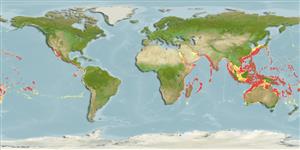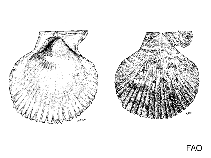Cryptopecten nux (Reeve, 1853)
| Native range | All suitable habitat | Point map | Year 2050 |

|
| This map was computer-generated and has not yet been reviewed. |
| Cryptopecten nux AquaMaps Data sources: GBIF OBIS |
Uploaden van je Foto's
Google afbeelding | No image available for this species;
drawing shows typical species in Pectinidae.
Google afbeelding | No image available for this species;
drawing shows typical species in Pectinidae.
Classification / Names Common names | Synonyms | CoL | ITIS | WoRMS
Bivalvia | Pectinida | Pectinidae
Environment: milieu / climate zone / depth range / distribution range Ecologie
; diepteverspreiding 5 - 918 m (Ref. 89006). Tropical
Verspreiding Landen | FAO regio's | Ecosystems | Voorkomen | Introducties
Indo-Pacific: from Red Sea to Melanesia, Micronesia and Polynesia.
Length at first maturity / Size / Gewicht / Leeftijd
Maturity: Lm ? range ? - ? cm
Minimum depth from Ref. 101147.
Life cycle and mating behavior Geslachtsrijpheid | Voortplanting | Kuitschieten | Eieren | Fecundity | Larven
Members of the class Bivalvia are mostly gonochoric, some are protandric hermaphrodites. Life cycle: Embryos develop into free-swimming trocophore larvae, succeeded by the bivalve veliger, resembling a miniature clam.
Voornaamste referentie
Referenties | Coördinator | Medewerkers
Raines, B. and M. Huber. 2012. (Ref. 93550)
Status op de Rode Lijst van het IUCN (Ref. 130435: Version 2024-1)
Status bij CITES (Ref. 108899)
Not Evaluated
CMS (Ref. 116361)
Not Evaluated
Gevaarlijk voor mensen
Harmless
Gebruik door de mens
| FishSource |
Tools
Meer informatie
Trophic Ecology
voedselitems
Dieet
Voedselconsumptie
voedselhoeveelheid
Predators
Dieet
Voedselconsumptie
voedselhoeveelheid
Predators
Ecology
Population dynamics
Groei
Leeftijd/Grootte
Lengte-gewicht parameters
Lengte-lengte parameters
Lengtefrequenties
Mass conversion
recrutering
Abundantie
Leeftijd/Grootte
Lengte-gewicht parameters
Lengte-lengte parameters
Lengtefrequenties
Mass conversion
recrutering
Abundantie
Life cycle
Voortplanting
Geslachtsrijpheid
Fecundity
Kuitschieten
Eieren
Ontwikkeling van de eieren
Larven
Populatiedynamica van de larven
Geslachtsrijpheid
Fecundity
Kuitschieten
Eieren
Ontwikkeling van de eieren
Larven
Populatiedynamica van de larven
Distribution
Human Related
Aquacultuurprofiel
Stamps, Coins Misc.
Stamps, Coins Misc.
Outreach
Taxonomy
References
Internet-bronnen
BHL | BOLD Systems | CISTI | DiscoverLife | FAO(Publication : search) | Fishipedia | GenBank (genoom, nucleotide) | GloBI | Gomexsi | Google Books | Google Scholar | Google | PubMed | Tree of Life | Wikipedia (ga naar, zoek) | Zoological Record
Estimates based on models
Preferred temperature
(Ref. 115969): 9.6 - 21.6, mean 15 (based on 576 cells).



